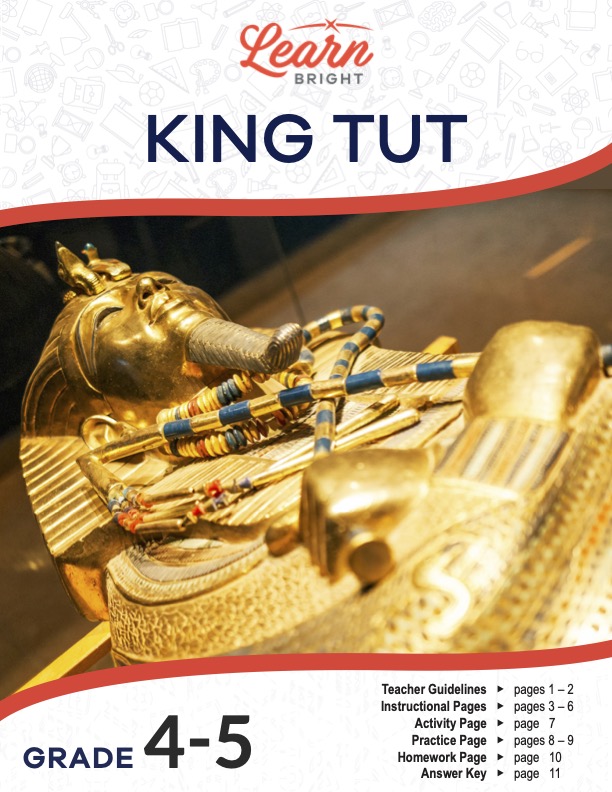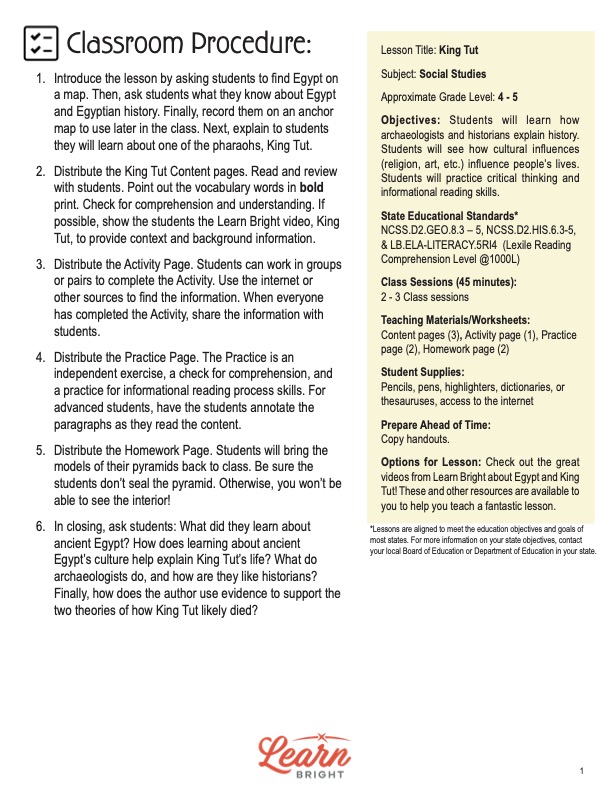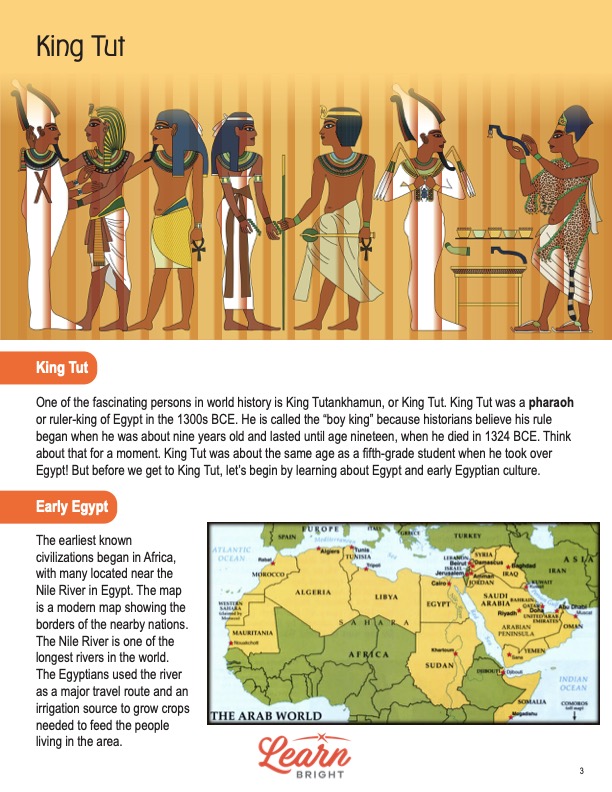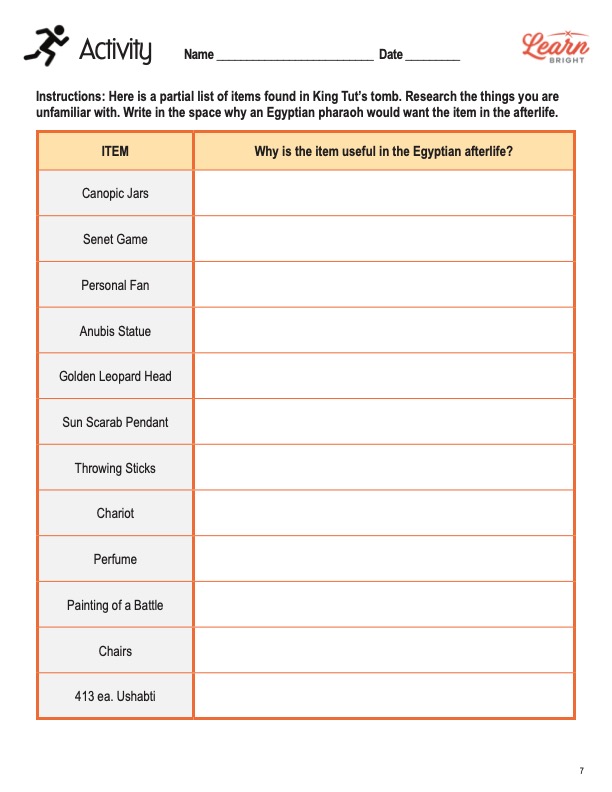Description
What our King Tut lesson plan includes
Lesson Objectives and Overview: King Tut explores the history of one of the most famous kings in Egyptian history. Students will learn how archaeologists and historians explain history and how cultural influences affect people’s lives. They will also practice critical thinking and informational reading skills. This lesson is for students in 4th grade and 5th grade.
Classroom Procedure
Every lesson plan provides you with a classroom procedure page that outlines a step-by-step guide to follow. You do not have to follow the guide exactly. The guide helps you organize the lesson and details when to hand out worksheets. It also lists information in the yellow box that you might find useful. You will find the lesson objectives, state standards, and number of class sessions the lesson should take to complete in this area. In addition, it describes the supplies you will need as well as what and how you need to prepare beforehand. This lesson requires pens, pencils, highlighters, dictionaries or thesauruses. Students will also need internet access.
Options for Lesson
The “Options for Lesson” section offers additional suggestions for ideas and activities to add to the lesson. You could check out the Learn Bright videos that cover the topics of Egypt and King Tutankhamun. These, along with other resources, can aid you in teaching a fantastic lesson!
Teacher Notes
The teacher notes page provides an extra paragraph of information to help guide the lesson. You can use the blank lines to write down any other ideas or thoughts you have about the topic as you prepare.
KING TUT LESSON PLAN CONTENT PAGES
Ancient Egypt
The King Tut lesson plan contains four content pages. One of the fascinating persons in world history is King Tutankhamun, or King Tut. King Tut was a pharaoh or ruler-king of Egypt in the 1300s BCE. He is called the “boy king” because historians believe his rule began when he was about nine years old and lasted until age nineteen, when he died in 1324 BCE. This means that King Tut was about the same age as a fifth-grade student when he began his reign!
The earliest known civilizations began in Africa, many of which were located near the Nile River in Egypt. The Nile River is one of the longest rivers in the world. Egyptians used the river as a major travel route and an irrigation source to grow crops to feed the people living in the area. They were also an incredibly technologically advanced civilization. For example, the Egyptians used papyrus, a stemmy plant that grows near the river’s edge, to make paper. In addition, they had an alphabet called hieroglyphics and invented advanced geometry methods for construction.
Many historians believe that the Greek and Roman cultures borrowed many construction techniques and architectural ideas from Egyptian culture. The Egyptians used ramps and levers to build the pyramids and buildings. More than likely, you have seen pictures of the pyramids in Egypt. The Egyptians did not have machines and construction equipment as we have today. Instead, they chiseled every pyramid part from quarries and placed them by hand. Concrete had not been invented, so each stone had to be perfectly cut and stacked on each other to fit into place.
Pyramids and Other Interesting Facts
When it comes to the ancient Egyptian pyramids, there is a lot of cool history. Each stone weighs around two tons. The Egyptians built the pyramids about 1,200 years before King Tut’s birth. The Pyramids of Khafre are 448 feet tall, which is around 100 feet higher than the Statue of Liberty. And 20,000 or more men worked on building the pyramids. Some say as many as 100,000 men worked on them!
And here is an interesting fact. If you ever wondered who invented toothpaste and dentistry, it was the Egyptians! They were very interested in healthcare, surgery, and teeth brushing. So they created toothbrushes, toothpaste, toothpicks, and breath mints. And, since we are talking about hygiene, the Egyptians took baths regularly and used perfumes, colognes, and cosmetics. We don’t think much about this stuff since it’s normal today. But in the ancient world, people rarely took baths or worried about how they looked or smelled. Egyptians were very fashion conscious!
Who Was King Tut?
As we said earlier, King Tut began his rule over Egypt as a child. In Egypt, the rulers came from the same family and passed the title of pharaoh from generation to generation. While Tut may have been the pharaoh, several advisors probably made the day-to-day ruling decisions.
The Egyptians were very religious. Pharaohs were not just rulers. The people believed they were gods. Egyptians worshiped several gods, and the pharaoh was the earthly god who communicated with all the others. Some historians believe the Egyptians had as many as 2,000 deities. The Egyptians’ religious beliefs focused a lot on the afterlife or what happens after a person dies.
The people believed that when a person dies, they pass to the afterlife in the same form as when they were alive. So they created elaborate burial processes to preserve the body for its new life in the afterlife. The process is known as mummification. Pharaohs were mummified and placed in elaborate tombs, like the pyramids.
Mummification of King Tut
Along with the mummified body of the pharaoh were items that the pharaoh might need in the afterlife. People believed the journey was long, so they would include items like food, jugs, clothing, jewelry, games, weapons, paintings, or even the family pet in the tombs of the pharaohs! In King Tut’s tomb, archaeologists found fruit baskets and dozens of artifacts.
Archaeologists are people who study history through excavating sites and analyzing artifacts and other physical remains. One reason we know so much about King Tut is that archaeologists discovered and explored his tomb. In 1922, Howard Carter, an archeologist, discovered the tomb along with the mummified body of King Tut.
King Tut was entombed in a coffin made of gold and gold inlay. Inside his tomb were 5,000 artifacts from his life and from Egyptian culture. Pharaohs were buried with personal items and items they wanted to take with them on their afterlife journey. Because of this, archaeologists could recreate the history of Tut’s life.
What Happened to King Tut?
Some historians believed King Tut might have been murdered by advisors who wanted to seize his power. Others believe family members who did not want to return to Amun’s religious worship may have caused his demise. There is a large hole on the back of Tut’s skull. The theorists who believe he was murdered use this as possible evidence that someone took a blow to Tut’s head.
Modern DNA testing and other evidence suggests Tut’s death was a result of several diseases. Tut was tall and very thin for an Egyptian and had a crippling club foot. DNA evidence shows he suffered from a bone disease. Furthermore, they provide proof that all depictions or artwork of the young king show him sitting while others participate in physical activities like archery. Tut also suffered from several infections and bouts of malaria, which may have contributed to his death. The hole in the back of his skull could be from the embalmer.
King Tut’s tomb is unusually small for a pharaoh. Historians interpret the small size of his tomb to mean that Tut died suddenly and unexpectedly, adding to the mystery of his death. Plus, the plethora of objects piled into the grave were unorganized, indicating his burial was completed quickly. His death remains a mystery. However, the historical importance of finding most of King Tut’s tomb intact after hundreds of years contributes greatly to our understanding of the cultural and technological significance of the Egyptians to world history.
KING TUT LESSON PLAN WORKSHEETS
The King Tut lesson plan includes three worksheets: an activity worksheet, a practice worksheet, and a homework assignment. Each one will help students solidify their grasp of the material they learned throughout the lesson. You can refer to the classroom procedure guidelines to know when to hand out each worksheet.
USEFUL IN THE AFTERLIFE ACTIVITY WORKSHEET
For the activity, students will look at a list of some of the items archaeologists found in King Tut’s tomb. They must research the items they aren’t familiar with to discover why they were useful in the afterlife. For each items, students will explain the items’ usefulness and why a pharaoh would want it in the afterlife.
REVIEW OF KING TUT PRACTICE WORKSHEET
Students will use the information they learned to answer six questions about King Tut or ancient Egyptian culture. You can choose whether or not to allow them to use the content pages for reference as they complete the assignment.
CREATE A PYRAMID HOMEWORK ASSIGNMENT
The homework assignment requires students to build a pyramid. The worksheet provides a template they can use. First, students will draw the blocks on the outside. Then they should find and add pictures of Egyptian art and hieroglyphics on the inside.
Worksheet Answer Keys
There are answer keys for the practice and homework worksheets in the lesson plan document. Answers may vary a little on the practice worksheets, but students’ responses should generally match those of the answer key. For the homework assignment, the answer key provides an example of what the pictures could look like on the inside of students’ pyramids. If you choose to administer the lesson pages to your students via PDF, you will need to save a new file that omits these pages. Otherwise, you can simply print out the applicable pages and keep these as reference for yourself when grading assignments.










